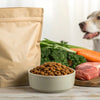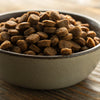How Much Dry Food for My Dog? A Comprehensive Guide to Dog Feeding
- Houndsy
Table of Contents
- Introduction
- Understanding Your Dog’s Nutritional Needs
- Calculating the Right Amount of Food
- Feeding Frequency: How Often Should We Feed?
- Common Pitfalls to Avoid
- The Houndsy Kibble Dispenser: Elevating the Feeding Experience
- Monitoring Your Dog’s Health and Weight
- Frequently Asked Questions (FAQ)
Introduction
As responsible dog parents, we often find ourselves pondering the question: how much dry food for my dog should I serve? In fact, studies have shown that nearly 60% of dogs in the U.S. are overweight or obese, a statistic that underscores the importance of proper feeding practices. The right amount of food can significantly influence our furry friends' health, energy levels, and overall well-being.
In this blog post, we will explore the various factors that determine how much dry food your dog requires, including age, size, activity level, and health status. We aim to provide you with actionable insights that will help you navigate feeding your dog with confidence and clarity. By the end of this post, you will understand how to assess your dog's individual needs and optimize their daily feeding routine.
So, whether you're a new dog owner or have years of experience, let's embark on this journey together to ensure our beloved pets receive the nutrition they deserve.
Understanding Your Dog’s Nutritional Needs
When considering how much dry food to feed your dog, it's essential to recognize that dogs, much like humans, have unique nutritional requirements. These needs can vary based on several factors:
1. Age
- Puppies: Young dogs require more calories and nutrients to support their rapid growth. They typically need a diet rich in protein and fats. Puppies should be fed three to four times a day, depending on their age and breed.
- Adult Dogs: Most adult dogs can thrive on two meals a day. The amount of food they need will depend on their size and activity level.
- Senior Dogs: As dogs age, their metabolism slows down, and they may require fewer calories. Senior diets often include joint-supporting nutrients to maintain mobility.
2. Size and Breed
Dog breeds vary significantly in size, which directly affects their caloric needs. Larger breeds generally require more food than smaller breeds, and activity levels can vary widely among breeds. For example, a Border Collie may need more calories than a Bulldog due to its higher activity level.
3. Activity Level
Active dogs burn more calories and therefore require more food. If your dog is highly active, participating in daily walks, runs, or play sessions, you may need to adjust their food intake accordingly. Conversely, more sedentary dogs may need less.
4. Health Status
Health conditions can also influence your dog's dietary needs. For instance, dogs with diabetes may require a specific diet that affects their caloric intake, while pregnant or nursing dogs need extra calories to support their puppies.
5. Body Condition Score
A dog's body condition score (BCS) is a visual assessment of their body fat. It's essential to assess this regularly to determine if your dog is at a healthy weight. A well-maintained BCS helps guide how much food to offer. If your dog is overweight, reducing their caloric intake may be necessary, while underweight dogs may need more food.
Calculating the Right Amount of Food
Once we understand the factors influencing our dogs' needs, the next step is calculating how much food to offer. Here are some steps to help guide you:
Step 1: Check the Feeding Guidelines
Start with the feeding chart on your dog food packaging. This chart provides recommended serving sizes based on your dog’s weight. Always remember that these are starting points—individual needs may vary.
Step 2: Use the Resting Energy Requirement (RER) Formula
To calculate your dog's daily caloric needs, you can use the RER formula:
[ \text{RER} = 70 \times (\text{weight in kg})^{0.75} ]
For example, a 10 kg dog would require approximately 400 calories per day (70 × (10 kg)^{0.75}).
Step 3: Adjust for Activity Level
If your dog is particularly active, you may need to increase their food intake by 20-50%. Conversely, less active dogs may need their intake reduced.
Step 4: Factor in Treats
Remember that treats should make up no more than 10% of your dog's daily caloric intake. It's essential to account for these when determining your dog's overall food portions.
Feeding Frequency: How Often Should We Feed?
Feeding frequency is another vital consideration. Here’s a general guideline based on age and size:
- Puppies: 3-4 meals per day until they are six months old.
- Adult Dogs: Typically 2 meals per day.
- Senior Dogs: 1-2 meals per day, depending on their health and preferences.
Adjusting meal times can help maintain stable energy levels and prevent hunger-related behavior issues.
Common Pitfalls to Avoid
1. Overfeeding
One of the most common mistakes dog owners make is overfeeding. While it may seem harmless to give a little extra food or treats, it can lead to obesity and related health issues. Always monitor your dog’s weight and adjust their food intake as needed.
2. Underfeeding
Conversely, underfeeding can result in nutritional deficiencies and low energy levels. Ensure that your dog receives a balanced diet that meets their specific needs.
3. Ignoring Feeding Guidelines
While dog food packaging provides guidance, it’s essential to view these recommendations as starting points. Each dog is unique, and consulting with a veterinarian can help tailor a feeding plan that fits your dog’s lifestyle and health status.
The Houndsy Kibble Dispenser: Elevating the Feeding Experience
At Houndsy, we understand the importance of providing the right amount of food in a convenient and aesthetically pleasing manner. Our flagship product, the Houndsy Kibble Dispenser, is designed to simplify and enhance your dog-feeding experience.
With its mid-century modern design and ergonomic crank, you can dispense perfect portions of dry food without bending over. The dispenser holds 25–30 lbs of kibble and features a BPA-free liner to ensure freshness. Plus, our auto-locking mechanism prevents accidental spills by curious pets or toddlers.
Explore the Houndsy Kibble Dispenser on our website to elevate your dog feeding routine! Order Now.
Monitoring Your Dog’s Health and Weight
Regularly assessing your dog's body condition and weight is crucial for fine-tuning their diet. Look for signs of a healthy weight, which include:
- Shiny coat and healthy skin
- Clear, bright eyes
- Good energy levels
- Firm, easy-to-pick-up feces
If you notice any changes, it may be time to reevaluate their feeding routine.
Frequently Asked Questions (FAQ)
How do I determine my dog's ideal weight?
The ideal weight can vary by breed and individual dog. Consult with your veterinarian to assess your dog's current weight and discuss an appropriate target weight.
Can I free-feed my dog?
Free-feeding can lead to overeating and obesity, and it’s generally not recommended unless you have a picky eater. Structured meal times are more effective for managing weight and energy levels.
What if my dog is a picky eater?
If your dog is picky, consider enhancing their meals with warm water or a small amount of wet food mixed in. However, avoid giving them table scraps or unhealthy treats.
What should I do if my dog is overweight?
If your dog is overweight, consult your veterinarian to develop a weight loss plan. This may include adjusting their food intake and increasing exercise levels.
How often should I change my dog's food?
If you’re switching to a new dog food, it’s best to do so gradually over a week or more to avoid digestive upset. Monitor your dog’s response to the new food and consult your vet if you have concerns.
Feeding your dog properly is one of the most significant ways to ensure their health and happiness. By understanding their unique needs and using tools like the Houndsy Kibble Dispenser, we can make mealtime not just a routine but a joyful experience.
For more information on creating a tailored feeding plan for your dog, or to explore our innovative pet care products, visit us at Houndsy! Explore More.












